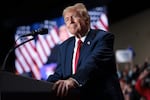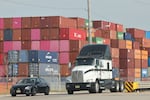
Former President Donald Trump speaks during a rally in Richmond, Va., on March 2. A second Trump administration could reshape the economy, from tariffs to tax cuts.
Win McNamee
A second Trump administration has the potential to reshape the economy in fundamental ways.
President-elect Donald Trump has promised to slap tariffs on imports, order large-scale deportation of immigrants and cut taxes and government regulations during his second term.
While it’s not certain when or how those policies might be enacted, here’s what they could mean for the U.S. economy.
Tax cuts
There’s a reason the stock market surged after Trump won the election. Investors expect a more business-friendly administration, including tax cuts.
During a new term, the former president wants to extend portions of the 2017 tax cut that are set to expire next year, and he has called for additional cuts in the corporate tax.
He has also floated the idea of exempting tipped income and Social Security benefits from federal taxes.
The ultimate size and shape of any tax cut may hinge on whether Republicans retain control of the House of Representatives. But the extension of most individual tax cuts, at a minimum, appears likely.
“Some additional tax cuts seem probable in our view, although the timing, size and specifics are highly uncertain,” Wells Fargo economists Jay Bryson and Michael Pugliese wrote in a research note, adding that additional cuts could lead to somewhat faster economic growth in 2026 and 2027.
Tariffs
The economic stimulus from tax cuts would be partially offset, however, by Trump’s proposed tariffs, which would raise costs for U.S. businesses and consumers and likely invite retaliation from U.S. trading partners.
Trump has proposed adding a tariff of 10% to 20% on all imports, with significantly higher levies on imports from China.

Shipping containers are seen at Port of Newark in Newark. N.J., on Oct. 4, 2024. Trump's plans to impose across-the-board tariffs could raise prices of a lot of goods while risking retaliation from trading partners.
Michael M. Santiago/Getty Images
Forecasters at Pantheon Macroeconomics project that a 10% tariff would increase inflation by about 0.8 percentage points next year and impose an additional drag on U.S. manufacturers.
While Trump says tariffs would encourage businesses to set up shop in the U.S., economists are dubious. “It will remain much cheaper to source goods from overseas, given relatively high U.S. labor costs, limiting the reshoring boost,” said Pantheon economists Samuel Tombs.
Government Debt
While tariffs would raise some additional revenue for the government, Trump’s overall economic platform — including the proposed tax cuts — are expected to widen the federal deficit, adding to the government’s borrowing costs.
The Committee for a Responsible Federal Budget estimates that Trump’s fiscal policies would add an extra $7.75 trillion in government debt over the next decade.
The prospect of so much additional debt spooked bond investors, sending bond yields sharply higher Wednesday. Mortgage rates, which tend to follow the yield on 10-year Treasuries, are expected to climb as well.
Immigration
Trump has called for mass deportation of immigrants who are in the country illegally. During his first term in the White House, Trump also took steps to curtail legal immigration, and his advisers have drawn up plans to do so again, The Wall Street Journal reports.
Analysts at the Brookings Institution, the American Enterprise Institute and the Niskanen Center project that net migration to the U.S. could be sharply lower — even negative — during a second Trump administration, with unfortunate consequences for the U.S. economy.

U.S. Border Patrol agents take asylum seekers into custody after they crossed a remote area of the U.S.-Mexico border near Jacumba Hot Springs, Calif., on Sept. 19, 2024. Trump's plan for mass deportations, if carried out, could deprive the economy of needed workers.
John Moore/Getty Images
Strict limits on immigration could choke off the supply of foreign-born workers who have been propping up the U.S. job market at a time when many baby boomers are retiring.
“There very well may be valid reasons to adopt such a policy,” Bryson and Pugliese from Wells Fargo write. “But, side effects of a policy that restricts immigration and deports undocumented people likely would be upward pressures on labor costs and a detrimental effect on the nation’s potential economic growth rate.”
The Federal Reserve
Inflation has cooled substantially, allowing the Federal Reserve to start cutting interest rates. But the central bank may proceed more cautiously if Trump’s policies put more upward pressure on prices. The central bank is widely expected to lower its benchmark rate by a quarter percentage point on Thursday. But Pantheon’s Tombs expects fewer rate cuts next year, as a result of Trump’s election.
During his first term in the White House, Trump frequently urged the Fed to cut rates more aggressively, at times berating Fed Chair Jerome Powell, whom he had appointed. Powell’s term expires in 2026, giving Trump the opportunity to nominate his successor. Trump could also replace Michael Barr as the Fed’s top bank regulator when his term as Vice Chair of Supervision expires that year.
The Fed is designed to be insulated from political pressure, so it can make unpopular decisions when necessary to curb inflation. That independence is central to the Fed’s credibility. Trump has routinely flouted that norm, however, suggesting the president should have a say in monetary policy.
Congress has generally defended the Fed’s independence but that could change in a second Trump administration.